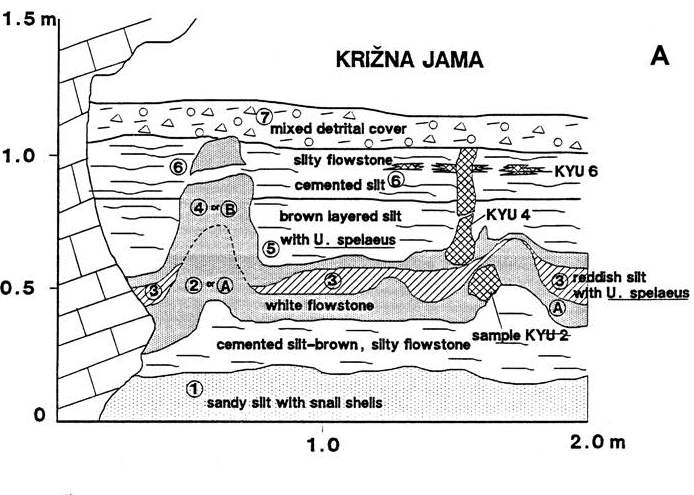Križna jama (SW Slovenia): Numerical-and correlated-ages from cave bear-bearing sediments
DOI:
https://doi.org/10.3986/ac.v39i3.82Povzetek
Križna jama is a large river cave located between Loško and Cerkniško poljes under Križna gora Mount in southern Slovenia. It has been known since the mid-19thcentury due to numerous cave bear finds. The cave is filled by complicated sequences of cave fluvial and lacustrine sediments, whichare recently partly eroded. We studied two paleontological excavations and profiles in the Medvedji rov to contribute to the solution of dating of bone-bearing lithological horizons. The Križna jama I profile consists of alternation of speleothem layers (flowstone sheets withsmall stalagmites, sometimes within situ cemented Ursus gr. spelaeus bones) and fine-grained siliciclastics often withbones of cave bear. It can be correlated withthe upper part of the Križna jama II profile, but witha slightly less preserved stratigraphic record. Radiocarbon and U-series dates clearly indicate two different ages of cave bear thanatocenoses in the Križna jama I profile: those above flowstone crusts were dated to ca. 47–45 ka by radiocarbon dating; those included in speleothem layers and clay interbeds are older than 94 ka (U-series date). The details of internal lithology, low thicknesses of layers and the state of bone preservation exclude expected sandwiching of younger layers into eroded/washed spaces among flowstones. Numerical dating excludes re-deposition of bear bones from older assemblage to sediments above flowstones. According to the paleomagnetic parameters (prevailing normal polarization), the deposition took place within the Brunhes Chron (< 780 ka). There were discovered in total four short-lived reverse excursions of the magnetic field. According to U-series data, the upper one (profile I) might be correlated withthe Blake excursion. The lower ones are older than ca 190 ka and can be correlated withsome of the Jamaica-Pringle Falls, Namaku, Calabrian Ridge, Portuguese margin or Calabrian Ridge 1 excursions. Sediments in studied profiles were deposited during the Last Glacial (Weichselian), Eemian interglacial, Saalian glacial and Holsteinian interglacial.
Prenosi

Prenosi
Objavljeno
Kako citirati
Številka
Rubrike
Licenca
Avtorji jamčijo, da je delo njihova avtorska stvaritev, da v njem niso kršene avtorske pravice tretjih oseb ali kake druge pravice. V primeru zahtevkov tretjih oseb se avtorji zavezujejo, da bodo varovali interese založnika ter da bodo povrnili morebitno škodo.
Podrobneje v rubriki: Prispevki




